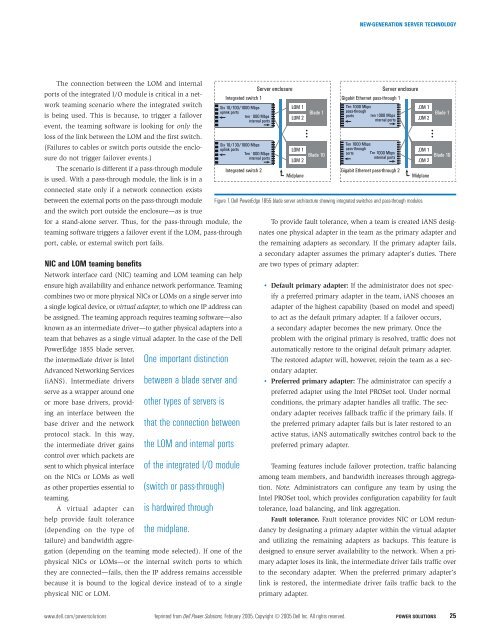Dell Power Solutions
Dell Power Solutions
Dell Power Solutions
- No tags were found...
Create successful ePaper yourself
Turn your PDF publications into a flip-book with our unique Google optimized e-Paper software.
NEW-GENERATION SERVER TECHNOLOGYThe connection between the LOM and internalports of the integrated I/O module is critical in a networkteaming scenario where the integrated switchis being used. This is because, to trigger a failoverevent, the teaming software is looking for only theloss of the link between the LOM and the first switch.(Failures to cables or switch ports outside the enclosuredo not trigger failover events.)The scenario is different if a pass-through moduleis used. With a pass-through module, the link is in aconnected state only if a network connection existsbetween the external ports on the pass-through moduleand the switch port outside the enclosure—as is truefor a stand-alone server. Thus, for the pass-through module, theteaming software triggers a failover event if the LOM, pass-throughport, cable, or external switch port fails.NIC and LOM teaming benefitsNetwork interface card (NIC) teaming and LOM teaming can helpensure high availability and enhance network performance. Teamingcombines two or more physical NICs or LOMs on a single server intoa single logical device, or virtual adapter, to which one IP address canbe assigned. The teaming approach requires teaming software—alsoknown as an intermediate driver—to gather physical adapters into ateam that behaves as a single virtual adapter. In the case of the <strong>Dell</strong><strong>Power</strong>Edge 1855 blade server,the intermediate driver is IntelAdvanced Networking Services(iANS). Intermediate driversserve as a wrapper around oneor more base drivers, providingan interface between thebase driver and the networkprotocol stack. In this way,the intermediate driver gainscontrol over which packets aresent to which physical interfaceon the NICs or LOMs as wellas other properties essential toteaming.A virtual adapter canhelp provide fault tolerance(depending on the type offailure) and bandwidth aggregation(depending on the teaming mode selected). If one of thephysical NICs or LOMs—or the internal switch ports to whichthey are connected—fails, then the IP address remains accessiblebecause it is bound to the logical device instead of to a singlephysical NIC or LOM.One important distinctionbetween a blade server andother types of servers isthat the connection betweenthe LOM and internal portsof the integrated I/O module(switch or pass-through)is hardwired throughthe midplane.Integrated switch 1Six 10/100/1000 Mbpsuplink portsTen 1000 Mbpsinternal portsSix 10/100/1000 Mbpsuplink portsTen 1000 Mbpsinternal portsIntegrated switch 2Server enclosureLOM 1LOM 2LOM 1LOM 2MidplaneFigure 1. <strong>Dell</strong> <strong>Power</strong>Edge 1855 blade server architecture showing integrated switches and pass-through modulesTo provide fault tolerance, when a team is created iANS designatesone physical adapter in the team as the primary adapter andthe remaining adapters as secondary. If the primary adapter fails,a secondary adapter assumes the primary adapter’s duties. Thereare two types of primary adapter:• Default primary adapter: If the administrator does not specifya preferred primary adapter in the team, iANS chooses anadapter of the highest capability (based on model and speed)to act as the default primary adapter. If a failover occurs,a secondary adapter becomes the new primary. Once theproblem with the original primary is resolved, traffic does notautomatically restore to the original default primary adapter.The restored adapter will, however, rejoin the team as a secondaryadapter.• Preferred primary adapter: The administrator can specify apreferred adapter using the Intel PROSet tool. Under normalconditions, the primary adapter handles all traffic. The secondaryadapter receives fallback traffic if the primary fails. Ifthe preferred primary adapter fails but is later restored to anactive status, iANS automatically switches control back to thepreferred primary adapter.Teaming features include failover protection, traffic balancingamong team members, and bandwidth increases through aggregation.Note: Administrators can configure any team by using theIntel PROSet tool, which provides configuration capability for faulttolerance, load balancing, and link aggregation.Fault tolerance. Fault tolerance provides NIC or LOM redundancyby designating a primary adapter within the virtual adapterand utilizing the remaining adapters as backups. This feature isdesigned to ensure server availability to the network. When a primaryadapter loses its link, the intermediate driver fails traffic overto the secondary adapter. When the preferred primary adapter’slink is restored, the intermediate driver fails traffic back to theprimary adapter.Blade 1Blade 10Server enclosureGigabit Ethernet pass-through 1Ten 1000 Mbpspass-throughports Ten 1000 Mbpsinternal portsTen 1000 Mbpspass-throughports Ten 1000 Mbpsinternal portsGigabit Ethernet pass-through 2LOM 1LOM 2LOM 1LOM 2MidplaneBlade 1Blade 10www.dell.com/powersolutions Reprinted from <strong>Dell</strong> <strong>Power</strong> <strong>Solutions</strong>, February 2005. Copyright © 2005 <strong>Dell</strong> Inc. All rights reserved. POWER SOLUTIONS 25








